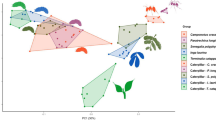Abstract.
Acacia ants (Pseudomyrmex spinicola) usually prune all of the vegetation growing in the vicinity of their host plant (Acacia collinsii). This lack of branches in contact with the host tree makes the main stem of the acacia the only point of access for ants invading the resident colony. The present study assessed whether the intrusion site affects the probability of the intruder being detected. It also investigated whether ants that remain inactive on the main trunk base (a) are involved in defensive duties and (b) are morphologically different from other colony members (e.g. foraging ants). In the field, intruder ants were placed on the trunk and leaves of acacias inhabited by P. spinicola; colony members on the trunk base and the leaves were marked and monitored; and head length, head width, and thorax length of ants that were either foraging on the leaves or immobile on the trunk were measured. P. spinicola ants found intruder ants entering their host acacia via the trunk more rapidly than those entering by means of the leaves. Ants on the base of the trunk do not exchange tasks with foragers: between 5 and 47% of the 1063 ants originally marked on the trunk were re-observed there, whereas only two of the 804 ants marked on the leaves were seen on the trunk. However, ants on the trunk were similar to foragers in morphology, suggesting that defensive ants may be part of a behavioral caste.
Similar content being viewed by others
Author information
Authors and Affiliations
Corresponding author
Additional information
Received 30 November 2007; revised 29 February 2008; accepted 17 March 2008.
Rights and permissions
About this article
Cite this article
Amador-Vargas, S. Spartan defense in the Thermopylae pass: Strategic defense by aggregations of Pseudomyrmex spinicola (Hymenoptera, Formicidae) on the trunk of Acacia collinsii (Mimosaceae). Insect. Soc. 55, 241–245 (2008). https://doi.org/10.1007/s00040-008-1000-y
Published:
Issue Date:
DOI: https://doi.org/10.1007/s00040-008-1000-y




